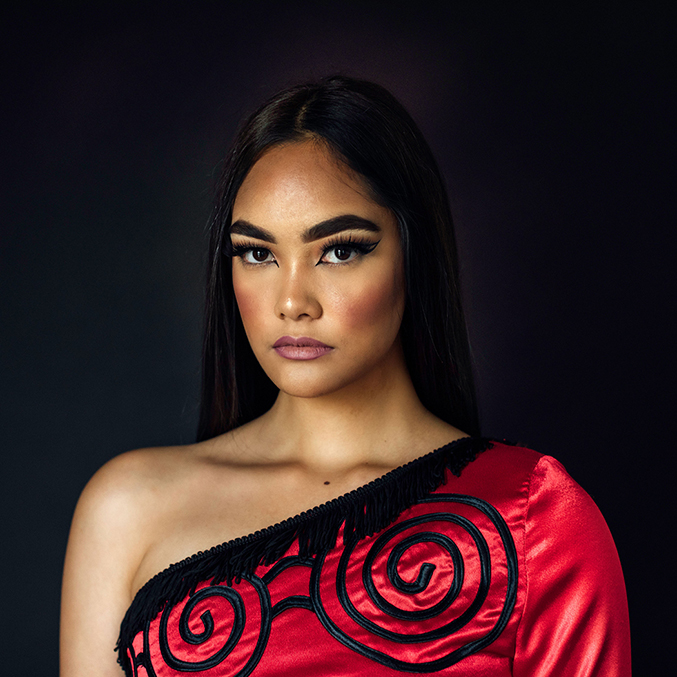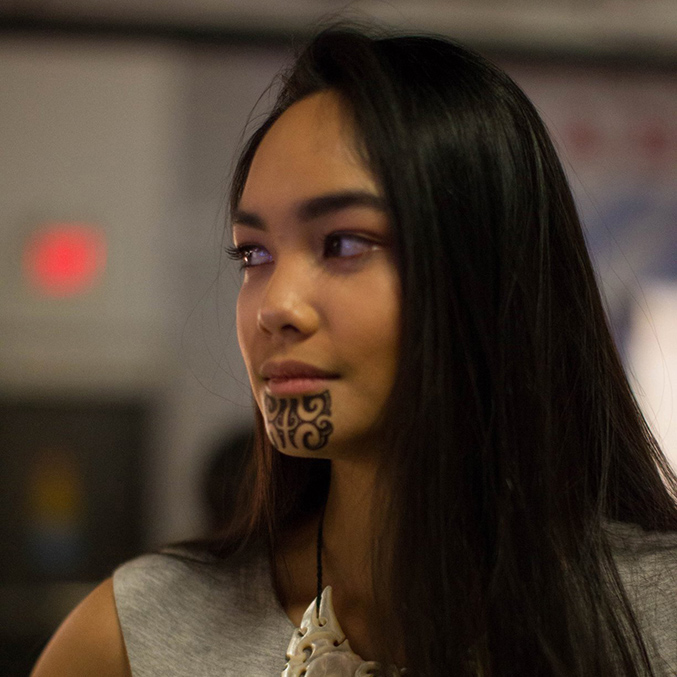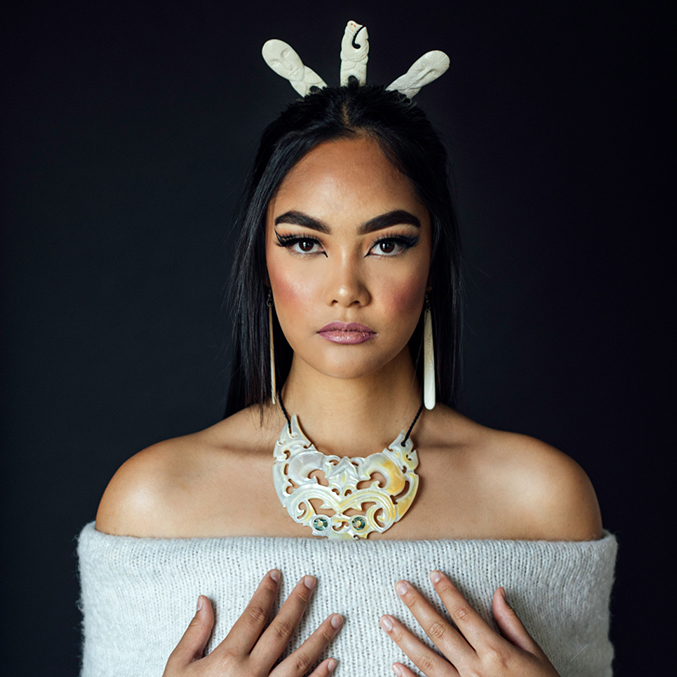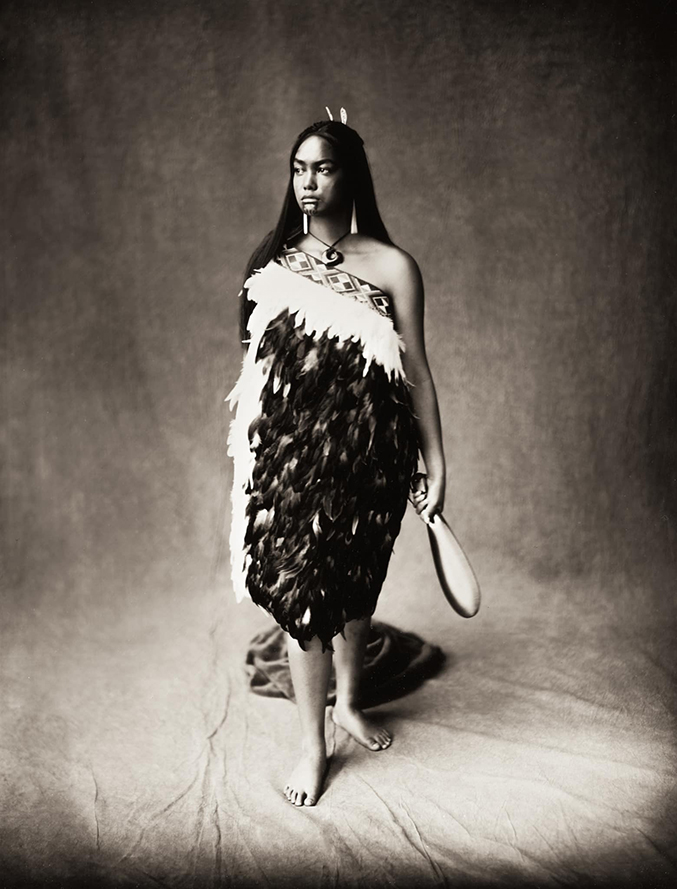
Sidney Nehua-Jackson (@sidneyahuaiti). Photo by Noella Steinhauer. Makeup by Amanda Steinhauer
Sidney Nehua-Jackson (17) is a wāhine (woman) Māori activist-model from Aotearoa, New Zealand. She has been officially invited, along with her sister, Hinauri Nehua-Jackson (19), to walk for Tishynah Buffalo Designs Sâkihisowin Collection at Rise New York City Fashion Show during New York Fashion Week.
“I love how the fashion industry is becoming more and more diverse, slowly but surely starting to move away from unhealthy and limited views of ’beauty’ and embracing people as they are,” she says.
Sidney recently graduated from high school and is taking a gap year to reconnect with her homeland, enjoy the modeling adventure and explore what lights her soul on fire before deciding what to study in college.
You just graduated from high school, and you’re taking a gap year. What are you thinking of doing?
My biggest goal is to go back home to reconnect with everyone and myself and the land. I’ll continue to model, of course, but I feel like that’s something I really need to do, to get a better understanding of who I am.
When I get there, I’m going to go with the flow. For so long, I’ve always had a plan because I love to keep things organized so I don’t stress out or waste time, but lately I’ve been more like, whatever happens, happens.
Feeling someone’s energy comes naturally to you.
Yes, spirituality and energies. I’m so big on energy and cleansing.
I can really sense and feel someone’s energy. When someone walks into a room that I don’t know, sometimes I just go quiet and take a feel for their energy to see where they’re at because for me, I think your energy speaks before you do.
Sometimes I can feel the heaviness when someone walks into the room, and I’ll ask them, “Hey, are you okay, what’s going on?” And then they tell me, and then I can say, “I had a feeling…” Other times I’ll tell myself, “go take a run” or “listen to music” or "just do something,” and that’s helped me—a lot—to get in touch my own feelings.
For instance, let’s say I feel like I’m getting a bit riled up, or someone is in a bad mood and I feel myself picking it up, and let’s say I’m in the car on the way to an event—I can roll down the window to let the energy out, so I’m not just sitting in that energy absorbing it.
But then other times I’m just like, “let it go, forgive, forget—live, love laugh.”
I’m all about “standards and boundaries” at the moment.
Boundaries is a big one for me too. In the past few months, especially, I’ve been invited to model by so many people. That’s great, but in the past, even if I was having the worse day ever, I would usually say, “of course!” because I didn’t know how to say no.
But then I wasn’t really emotionally present.
Lately, I’ve been able to say no. Now that I’ve graduated, I just need to really tune into myself right now. Navigating how to continue this because I am not one to take a step backwards.
How lovely that you and your sister, Hinauri, support each other’s modeling careers.
Coming up in this industry with my older sister by my side was one of the best decisions we’ve made so far. Modeling bought us closer, as we bonded over the excitement and passion of it all. We’ve grown to become each other’s backbones and helpers in many different ways.
You’ve got this modeling career now, and you’re doing so well.
I know that most people my age don’t even have the opportunity to model, and they don’t have an understanding and awareness of the industry. Just going to New York at my age—that’s huge in and of itself. I am so blessed.
And you’ll be walking for Tishynah Buffalo at Rise New York Fashion Week.
Tishynah was the first designer I ever walked for, back in 2017, in Alexander First Nations. She made me feel seen, heard, and comfortable from the beginning. I modeled for her again in 2019 for Western Canada Fashion Week. She is a great person to be around.

Sidney Nehua-Jackson wearing her moko. Photo by Aaron Menor
How does it feel to wear a moko (traditional Māori chin marking) when you model?
Every time I wear my moko kauae on the runway, I feel like a part of me heals. I feel powerful. Knowing I can proudly wear it with my ancestors walking next to me brings out a side of me I really want to explore further. My younger self was afraid to express her māoritanga. She’s growing and healing within everything I do now.
How do you feel when you’re walking the runway?
I’m always excited to walk the runway; it makes me feel so powerful and beautiful. Wherever I am—in school hallways, grocery store aisles, or sidewalks—I always treat it like my own personal runway. It’s good practice and a confidence boost.
Walking the runway takes confidence. Would you say that you are an introvert, extrovert, or ambivert?
I like to think I’m an ambivert, so it depends on the situation. When I’m in a new space, whether it’s a new school or event, I tend to be an introvert. I like to get a feel of the energy in the room first. If I’m around a few people I know or in a professional setting, I become an extrovert right away.
My mother and sister take to networking naturally. They helped me break out of my introvert stage by holding a safe space for me where I could learn to feel more comfortable talking to different groups of people. I’ve found my own voice now and love sharing my passions with the world.

Sidney Nehua-Jackson. Photo by Noella Steinhauer. Makeup by Amanda Steinhauer
Moving from Aotearoa, New Zealand, to Amiskwaciy Waskahikan (Alberta, Canada) in 2015, must have a been a major change for you.
I was only 11 when I moved to Canada, and navigating a new country and being separated from my culture was both exciting and scary for me. Over time, I lost touch with my māoritanga (Māori way of life) trying to fit in, but then the fashion industry helped me reclaim it.
I was surrounded by talented people who were unapologetically Indigenous, who inspired me to feel and do the same.
I learned that if I stay true to myself, everything else will fall into place.
What are some of the issues you are passionate about?
My whānau (extended family) raised me to fight for Earth rights, Māori rights, and the rights of Indigenous people. This comes so naturally for me. I am not afraid to speak up when I see or feel something isn’t right and I’m very passionate about the topic. My ancestors fought to have the language and traditions that I'm so lucky to have now. I will continue to learn, share, and protect them with all that I am—because they are who I am.
Thank you for being a love warrior for Papatūānuku (Mother Earth).
I will never stop fighting for Papatūānuku (Mother Earth). I grasped the importance of our land even as a young girl. She holds generations of stories and traditions and provides us with everything we need, whether that’s food, land, water, etc.
Mother Earth isn’t just something that we live on. She is my relative. I feel the need to protect her from all the harm she encounters. And it’s not just the land we need to protect—it’s also the oceans and wildlife. I was taught by my elders and knowledge keepers that all living things are Mother Earth’s babies and that we’re all connected, and that every decision we make in the present will affect future generations.
You come from a powerful and inspiring line.
Watching videos of my pumama (grandmother) Deirdre Nehua and koro (grandfather) Syd Jackson fight for the land and Māori language rights inspired—and continues to inspire—me. And also, hearing the stories from my pumama of her experiences throughout her lifetime is so important. I cherish them.
Is that you in this amazing photo with the LAND BACK banner?
Yes! That's me, second from the right. My sister is right next to me, second on the left.
This was one of the biggest protests I’ve been a part of here in Amiskwaciwâskahikan (Edmonton), and it was to fight climate change—alongside Greta Thunberg, who was in attendance.
I’ll never forget being up on those stairs with these wāhine toa and the feeling of community surrounding me as we walked the streets of downtown Edmonton. I remember the smell of burning sage throughout the crowd and the voices of singers, protesters, and the sound of the drum.
This is the moment I found my voice. I realized that a part of me wanted to pursue political science like my koro (grandfather), Syd Jackson. A side of me opened up that I am still exploring—and enjoying.
What does “ataahua, ataahua” mean in this photo caption?
There was a Tik Tok trend going around saying, “Gorgeous, gorgeous girls…” and you would add your own saying to it.
I had made this Land Back rhinestone top at 2 a.m. on the floor in my sister’s room while she created her own rhinestone blazer design.
The next day, I wore the shirt to school and took photos in the parking lot across the road. While I was looking at the pictures and thinking of a caption, some girls walked past me saying, “Gorgeous, gorgeous girls...” and I thought, “Wow—how about if I indigenize this a bit?” I came up with, “Ataahua, ataahua people want their mf land back.” Ataahua means ‘beautiful,’ so it’s, “Beautiful, beautiful people want their mf land back.”
And we do.
In Aotearoa, we want the government to return whenua raupatu (stolen land) to Māori ownership. But it isn’t just us. Indigenous people around the world also want their stolen land back.
In simple terms, what does “Land Back” mean to you?
To me, “Land Back” means putting Indigenous people in control of the management and decisions being made on behalf of the land. We have a deep connection with the land and water that goes back many generations, and we are no more or less than any other living creature on this earth.
Tell me about your Iwi (tribes).
NgātiWai, Ngāti Whātua ki Orakei, Ngāti Kahungunu Ki Heretaunga, Ngāti Porou and Ngāpuhi are each different Iwis that I’m from. Iwi isn’t just where I’m from or the name of my people—it is my bones—where my strength comes from. I have genealogical ties to the lands of each of my tribal affiliations. But it’s even more than that.

Sidney Nehua-Jackson by Shane Balkowitsch
You recently represented your iwi (tribe) for Shane Balkowitsch, who has photographed thousands of people, including celebrities and historical figures for his Wet Plate Collodion. How was the experience?
I was the first Tangata Māori Shane had ever photographed. He has the best energy I’ve ever come across and a willingness to listen, learn, and educate me about the work he does. He created an instant connection that I truly admire. I am honored to have worked with Shane and hope to collaborate with him again in the future.
Tell me about the korowai (feather cloak) you are wearing and the patu (war club) you are holding.
In pre-colonial days, the patu was used in combat when at war. Today, many people use the patu in kapa haka (Māori action songs).
My korowai was gifted to me by my pumama when I graduated ninth grade. Korowai represent honor, and many people wear them when at graduations, weddings, or when performing. When I wear my korowai, I feel my whakapapa (genealogy) and ancestors hugging me. As it wraps around my body, I feel sacred.
I was so happy to see Trevor Noah (@trevornoah) on The Daily Show (@thedailyshow) talking about the Te Pāti Māori (Māori Party) petition to officially change New Zealand’s name to Aotearoa, which was recently submitted to parliament.
YES!!! I think it’s amazing. I’ve always seen it as Aotearoa—that’s my home. Whenever I introduce myself to others, I say, “I’m from Aotearoa,” not “New Zealand.” I often say “Aotearoa, New Zealand.”
As do I. I love to see different places renaming their areas to its original name. I think it’s beautiful and important.
Yes, and it’s sad that even back home, we weren’t really taught about a lot of names in Māori. That’s been improving throughout the years (thankfully), but growing up, I didn’t even know that Auckland was Tāmaki Makaurau.
I didn’t, either! Thank you. All we got in HIS-story was Captain Cook’s “discovery of New Zealand,” which I knew was colonial propaganda even as a kid in 1970’s Aotearoa.
Captain Crook was never taught at my school. We had a Māori unit, which was basically kura kaupapa Māori, and every parent—yes, every parent whose child went into “Te whānau Whariki” (the Māori unit)—fought to not teach us about Captain Cook and to teach us about tīkanga Māori instead. Once we reached year 5 - 6, we were taught the colonial side of the story, about how he “discovered New Zealand.”
I would have loved that!
We had a principal who tried to just get rid of the Māori unit completely, and you best believe my mom fought that along with other teachers and parents. My mom was actually banned from the school ground because she fought so hard!
I am amazed and inspired by her ongoing work, which I’ve watched my entire life. She is the reason I’m not afraid to speak up and speak out about things that matter to me. And as I learn more, I understand and appreciate what all the parents did in order to keep the kura kaupapa Māori running.
I love to learn. I learn new things every day. I will be on a learning journey until the day I die.
What excites you most about the fashion scene today?
I love how the fashion industry is becoming more and more diverse, slowly but surely starting to move away from unhealthy and limited views of “beauty” and embracing people as they are.
How would you describe your own personal style?
My style changes all the time.
I love to try new combinations of clothes inspired by my Pinterest home page. I often scroll through Pinterest for hours on end, adding things to my Fashion board to give me different ideas ranging from Archive Fashion to Bella Hadid street style. Pinterest is so great! I have my own little digital Vision Board called “2022” with all of what I want to manifest this year.
I love to go for an “off duty model” look whenever I’m out because I never know who I will run into. If younger me saw me the way I am now, she would be so happy.
I love how you mix it up with traditional and contemporary clothing in the photoshoot, especially the piupiu (a skirt worn during Māori dances).
I was looking in my mom’s room for the photoshoot, and I came across the piupiu, and my mom said it was broken, but when I pulled it out, it was in perfect condition, and I was like, “Can I wear this?”
The red dress was my grandmother’s wedding dress. I wore it to my graduation. I was so honored to wear it, and I felt like the prettiest girl alive.
You are an activist-model. If you could only choose five causes you are passionate about, what would they be?
MENTAL HEATH EDUCATION. I think mental health—especially for males—is a big, important topic that more people need to take seriously. I will always speak about it.
Growing up, I never talked about mental health with family or friends, and that lead me to a really dark place trying to navigate how to deal with healing and recovering from the hardships and trauma that I survived. It was not an easy journey. I had no one to talk about it with except my gym teacher, who I trusted so much! She listened, and she taught me about mental health, and even shared her own experiences with me. Thankfully, I’m now in a place where I can be a helping hand to others, and can listen and share without the feeling of carrying their weight on my shoulders.
BEYOND ONE-SIZE MODELS. I’d like to see the industry move beyond “one size” models. Models shouldn’t be restricted to one size. Whatever size you are is perfect. I hear so many stories about how the industry is “cut-throat” when it comes to size and height, and in most cases, that’s sadly true. Personally, I don’t think that way, and I never will. Whoever you are is beautiful.
GLOBAL INDIGENOUS RIGHTS. Indigenous rights all around the world has been something I’ve grown up advocating for because, from the day I was born, I watched my mother and grandparents fight for us. I’ve naturally adapted to it. I’m thankful that I’ve become aware of the ongoing issues Indigenous people continue to face, because that opens a door of opportunity for me to educate my friends and family—and myself too, of course, as there’s always so much more to learn.
PROTECTING MOTHER EARTH. Protecting Mother Earth and all of her children—animals, plants, and all living things from harm. We depend on our Mother Earth. Without her, we ultimately won’t survive.
MORE GENDER-FLUID CLOTHING. I would go deeper into gender-fluid clothing, meaning, men can wear skirts and dresses and woman can wear suits. I don’t think clothes should have a gender label on them. I think people should be able to wear whatever they want, whenever they want. I don’t think certain items of clothes, like dresses or skirts, should be restricted to one gender. You should be able to wear anything you want to wear.
There was a woodshop class in junior high, and that was known to be where the guys were, but we had to take an option, so I took it anyway. I loved it. I felt so creative, and I felt like I was supposed to be there. I remember thinking, “Why is this a man’s job? Women can do woodwork, too.” Why does it have to be like that? That’s so frustrating.
It's so important to take care of yourself. Especially in the public eye.
No matter what we choose do, there will always be critics. There will always be people who do not support your decision—at the end of the day.
It was really hard at first, but I’ve learned that as long as you stay true to yourself and your feelings, other people’s perceptions of you don’t matter—because they don’t know you the way you know yourself.
Every challenge that I’ve gone through brought me to where I am today, which I’m thankful for, to say the least. But back then when it was happening, I couldn’t understand—I couldn’t see the future—but as I’ve grown, I can see it clearly.
When I see someone else going through something hard, I really care.
A lot of young people—and especially a lot of my peers in the Polynesian community— don’t talk about mental health. I’ve noticed because I’ve been around it. They really don’t take it seriously, and that can be harmful to a lot of people my age.
I see it every day on TikTok. I was scrolling last night, and I came across all these new postings about it and people opening up emotionally. I think it’s sad they don’t get those reminders that they’re not alone, and just words like “I’m proud of you, and I think you’re amazing” and “you’re doing great” and “I appreciate you.” Just having a helping hand and just hearing those words can mean so much. A lot of people don’t hear those words every day.
Why is representation important to you?
Representation matters to me because it allows me to dig deeper and become more confident in where I come from and who I am. When I see Indigenous models, designers and artists accomplish their goals, it makes me think, “Wow! If they can do it—I can, too.”
I think proper representation matters a lot more now, especially because we see brands misrepresent many cultures digging into stereotypes and sexualization of many different groups, and it leads to things like “Reservation Royalty” or “Native American Indian Sweetheart Costume.” NOT OKAY.
Last year in my Indigenous Studies class, we studied the misrepresentation of Native American cultures through Halloween costumes, and oh my—it made my blood boil!
Is there anyone else who you’d like to give a gratitude shoutout to?
My community has been my backbone since day one, and my māmā and pumama have taught me so much. I wouldn’t be where I am today without them and their ongoing support and guidance, and their sacrifices never go overlooked by me. Ever.
I am also thankful for so many people who helped me grow in many ways within the industry.
Photo by Noella Steinhauer (@noellasteinhauer)
Makeup by Amanda Steinhauer (@forever_flawless_mu)
#SidneyNehuaJackson #Māori #ActivistModel #activist #model #EarthDefender